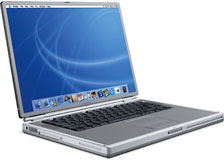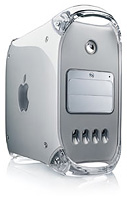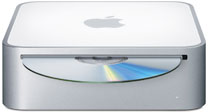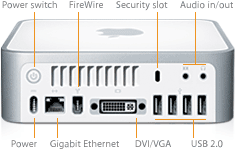Mac Musings
It's All About the Upgrades
Daniel Knight - 2012.01.09 -
In anticipation of tomorrow's sixth anniversary of the first Intel-based Macs being introduced, we've asked our writers who have used Intel Macs to reflect on their first experiences with the new hardware platform.
A Long History with Macs
I've been using Macs since late 1986, and I remember the teething problems when the first 68020-based Macs arrived, when Apple added 32-bit operation to the older 24-bit mode in System 7, how some apps really broke when the more efficient 68040 chips arrived, and how seamless the transition to PowerPC seemed. Apple supported old hardware with new operating systems for years, and the equipment was built to last. That was a big part of the reason I launched Low End Mac nearly 15 years ago.
 Apple
made some huge changes when it introduced Mac OS X to replace the
Classic Mac OS, and for the first year or two of the OS X Era, it
was the realm of early adopters. My 400 MHz Titanium PowerBook ran
Mac OS 9 just fine, thank you very much, and I loved the apps I was
using: AppleWorks, Claris Home Page, Claris Emailer, Photoshop 4.0 and
5.5, BBEdit Lite, Microsoft Word 5.1a, FileMaker Pro (I think version
3), and more. I knew my tools and had a remarkably efficient workflow.
There was no compelling reason to leave OS 9 behind, so I didn't
even start experimenting with OS X until about the time OS X 10.2 Jaguar came out.
Apple
made some huge changes when it introduced Mac OS X to replace the
Classic Mac OS, and for the first year or two of the OS X Era, it
was the realm of early adopters. My 400 MHz Titanium PowerBook ran
Mac OS 9 just fine, thank you very much, and I loved the apps I was
using: AppleWorks, Claris Home Page, Claris Emailer, Photoshop 4.0 and
5.5, BBEdit Lite, Microsoft Word 5.1a, FileMaker Pro (I think version
3), and more. I knew my tools and had a remarkably efficient workflow.
There was no compelling reason to leave OS 9 behind, so I didn't
even start experimenting with OS X until about the time OS X 10.2 Jaguar came out.
Even then, for the first few months I worked exclusively in Mac OS 9, only booting into OS X when I had time to play with the new environment. I had Jaguar on my Titanium PowerBook, a 266 MHz Power Mac G3, and a 333 MHz iMac, and it just felt slow compared to the perky old Mac OS. But things improved quite a bit with OS X 10.3 Panther, which was much more efficient, and that's when we started to see OS X apps that were an improvement over the Classic Mac ones.
 Thank goodness
for Classic Mode, which to this day lets me continue to run Claris Home
Page on one of my G4 Power Macs with OS X 10.4 Tiger, which was the
last version to support Classic Mode. When I acquired a secondhand
dual 1 GHz Mid 2002 MDD
Power Mac G4 (the machine I'm writing this on) about 8 years ago, I
discovered how much more powerful a dual-processor machine was, and
since then I've only bought dual-processor or dual-core Macs.
Thank goodness
for Classic Mode, which to this day lets me continue to run Claris Home
Page on one of my G4 Power Macs with OS X 10.4 Tiger, which was the
last version to support Classic Mode. When I acquired a secondhand
dual 1 GHz Mid 2002 MDD
Power Mac G4 (the machine I'm writing this on) about 8 years ago, I
discovered how much more powerful a dual-processor machine was, and
since then I've only bought dual-processor or dual-core Macs.
I love Tiger and resisted OS X 10.5 Leopard until one of the apps I depended on compelled me to make the switch or be left behind. NetNewsWire is that good an RSS reader, so I acquired a second dual-processor Power Mac G4 and made it my Leopard machine, using a program called Teleport so I could control both Macs with one mouse and keyboard. This is when I began to use Apple's Mail app, so the Leopard Mac (eventually upgraded with a dual 1.6 GHz processor card) became my browsing and email machine, while the Tiger Mac was my writing, editing, and uploading machine. Either one would be used for AppleWorks and Photoshop Elements 3.0.
My First Intel Mac
 Last
winter I decided it was about time I got my first Intel-based Mac.
Google's Chrome browser was getting a lot of press and OS X 10.6
Snow Leopard had shipped as the first Intel-only Mac operating system,
so I started setting aside money and checking out the local Craigslist
for a good deal. It was about March 2011 when I found a winner, a
2.0 GHz Core 2 Duo Mac mini
from 2007, the oldest model that supports 64-bit operation, with a 23"
Apple Cinema Display, a DVI-to-ADC video adapter, and a spare 80 GB USB
hard drive. All that for $675.
Last
winter I decided it was about time I got my first Intel-based Mac.
Google's Chrome browser was getting a lot of press and OS X 10.6
Snow Leopard had shipped as the first Intel-only Mac operating system,
so I started setting aside money and checking out the local Craigslist
for a good deal. It was about March 2011 when I found a winner, a
2.0 GHz Core 2 Duo Mac mini
from 2007, the oldest model that supports 64-bit operation, with a 23"
Apple Cinema Display, a DVI-to-ADC video adapter, and a spare 80 GB USB
hard drive. All that for $675.
 It
was a revelation. If I ran just one or two apps, it was pretty speedy.
The 5400 rpm hard drive was no speed demon, and with just 1 GB of
memory, the Mini came to depend on slow virtual memory once I had just
a few programs running. OS X 10.6 Snow Leopard was a bit of a
memory hog, but I was able to keep up-to-date with the latest versions
of Chrome, Firefox, Safari, and other apps. The Mini became my primary
email and RSS machine, but until I could afford a bigger, faster hard
drive and a memory upgrade, I did most of my work on the G4 Power
Macs.
It
was a revelation. If I ran just one or two apps, it was pretty speedy.
The 5400 rpm hard drive was no speed demon, and with just 1 GB of
memory, the Mini came to depend on slow virtual memory once I had just
a few programs running. OS X 10.6 Snow Leopard was a bit of a
memory hog, but I was able to keep up-to-date with the latest versions
of Chrome, Firefox, Safari, and other apps. The Mini became my primary
email and RSS machine, but until I could afford a bigger, faster hard
drive and a memory upgrade, I did most of my work on the G4 Power
Macs.
One day I filled my hard drive, and that was not good. Do that, and your Mac won't run. Time to buy a bigger drive, so I picked up a 320 GB 7200 rpm WD Scorpio Black from the local Best Buy, partitioned it with separate Leopard and Snow Leopard partitions, cloned the old internal drive and the external drive to it, and saw a fair increase in performance. But most of all, the Mini would now boot and let me work.
The big speed boost came when I had the $60 or so for a 3 GB memory upgrade from Other World Computing, which is the maximum this version of the Mini supports. That made a world of difference, and now the Mac mini could become a serious production machine with plenty of memory for running Mail, Photoshop Elements, NetNewsWire, TextSoap, two or more browsers, TextWrangler, and several other apps at the same time. I was finally more productive on the Mac mini than on the older, slower Power Macs, which were much more memory efficient with Tiger and Leopard than the Mini was with Snow Leopard.
I remember how people used to get down on the Intel GMA 950 integrated graphics, but I've run the Mini with 1600 x 1024, 1680 x 1050, and now 1600 x 1200 displays and never noticed and graphical slowdown. Maybe gamers would see the difference, but it's perfectly adequate for my purposes.
My Next Mac
Much as I'd love a notebook - whether a PowerBook G4, iBook G4, or Intel-based MacBook - my next computer is sitting in the basement waiting for a few hours so I can swap out drives and memory. Despite all the Intel goodness of the Mac mini, I've become spoiled using three Macs for production, and I got a great deal from Advanced Technology Recycling on three 1600 x 1200 Dell monitors (so all three Macs have matching displays), two 7200 rpm 80 GB hard drives, and a dual 1.25 GHz MDD Power Mac, which will give my Tiger machine a 25% performance boost.
Yes, my latest acquisition isn't an Intel-based Mac or even a G5 model, but another 2002 Power Mac G4. I just love working in Claris Home Page in Classic Mode under OS X 10.4 Tiger. I can work on web pages on the Tiger Mac, have a browser window open for reference on the Leopard Mac, which is in the middle, and use the Mac mini with Snow Leopard for email, NetNewsWire, and other browsing. (It's not uncommon to have two or more browsers running on each of these Macs.)
Someday I hope to get a nice notebook. Someday I'm sure I'll replace the Mac mini with something a bit newer than 2007. And someday I'll probably even give OS X 10.7 Lion a try. But I don't think I'll ever go back to a single production Mac, and I'll probably continue to run my G4 Power Macs until they just won't run any longer.
I'm glad I've had the chance to go Intel, to experience the future of the Mac platform, but I'm every bit as glad that I can keep using the productivity tools that have become second nature over the past 15 years, in the case of Claris Home Page, and 21 years in the case of AppleWorks (I bought ClarisWorks 1.0 for my Mac Plus in early 1991). What's really amazing is that AppleWorks, a PowerPC-only program that Apple pretty much abandoned in 2003, works so remarkably well on this Intel Mac using a version of OS X that's just one generation out of date.
This is Low End Mac, after all, and while we would all love to have the latest and greatest hardware, the reality is that we have limited budgets - and that so often all that new hardware won't really make us any more productive when browsing the Web or writing articles for publication.
Oh, and upgrades make all the difference. My Tiger Mac has 2 GB of memory, my Leopard Mac has 1.25 GB (out of a possible 1.5), and my Mac mini has 3 GB. All my Macs have 7200 rpm hard drives. And while they ran decently with their stock drives and memory, they are far more powerful with these upgrades. (In other words, if your Mac seems sluggish, it could be limited memory and/or a slow hard drive, not processor speed that's the limiting factor.)
Join us on Facebook, follow us on Twitter or Google+, or subscribe to our RSS news feed
Dan Knight has been using Macs since 1986, sold Macs for several years, supported them for many more years, and has been publishing Low End Mac since April 1997. If you find Dan's articles helpful, please consider making a donation to his tip jar.
Links for the Day
- Mac of the Day: 17" MacBook Pro Core Duo, (2006.04.24. The top-end MacBook Pro has a 1680 x 1050, 2.16 GHz Core Duo CPU, and supports Apple's 30" Cinema Display.)
- Support Low End Mac